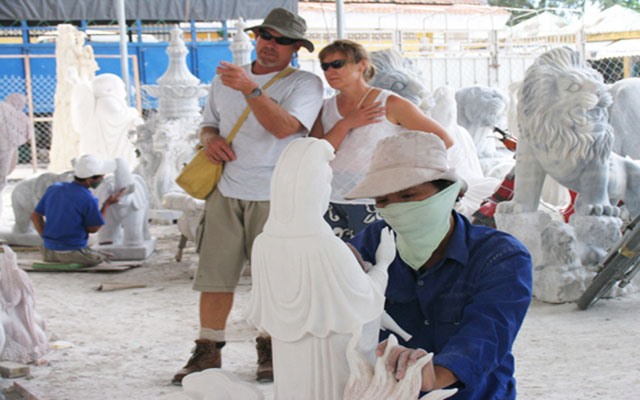 Society
Society

Despite ups and downs throughout history, many artisans in the Mekong Delta province of An Giang’s Thoại Sơn District have spared no effort in promoting the arts of stone carving, which has been handed down over many generations.
 |
| Foreign tourists visit a workshop carving stone items in Thoại Sơn District, Mekong Delta’s An Giang Province. — Photo dulichthoaison.com |
AN GIANG — Despite ups and downs throughout history, many artisans in the Mekong Delta province of An Giang’s Thoại Sơn District have spared no effort in promoting the arts of stone carving, which has been handed down over many generations.
The district’s craft of carving stone into ornate figures and shapes dates back hundreds of years, stemming from the exploitation of stone for construction and making household goods.
Local artisans gradually moved to more artistic endeavors, including products such as mortars, censers, tombstones, statues and other decorative items. With their high skills, the craftsmen would transform lifeless stone into exquisite items full of abstract and lively images.
Lê Trọng Sơn, from Thoại Giang Commune, told the Thanh niên (Young People) newspaper that his family has lived from the craft of stone carving for three generations.
“My father used to make tombstones and mortars. But I have moved to carve stone more artistically,” he said.
Before 2000, 80 per cent of local people living around Sập Mountain in Thoại Sơn District made a living from the exploitation and carving of stone. However, local authorities banned the exploitation of stone in 2001 to protect the mountain from collapse due to over-exploitation. Hundreds of thousands of tonnes of stone were exploited each year.
Since that decision, many people were forced to change their line of work.
Sơn was one of the few local artisans in the district who tried to continue promoting the craft.
Sơn, along with seven other artisans from his group, often makes stone products following customers’ orders, producing stone carvings ranging from simple to sophisticated designs.
They also carve stone products for decoration and display such as statues. Through their talented and skillful hands, inanimate stones are turned into lively works of art.
“My products are not always for sale. Sometimes I just try to create unique products for display or simply to satisfy my passion for this craft,” he said.
“I have visited many craft villages in different localities to learn from other stone carving artisans,” he added.
His group’s products have gradually earned the admiration of customers around the country. Many customers place orders for stone products, including decorative items such as ornamental plant pots, stone sculptures and water fountains, as well as spiritual ones like Buddha statues and objects for worship.
Finding stone
Finding stone to make products is not easy, according to Đoàn Trung Tính, another artisan in Thoại Sơn District.
“It is necessary to carefully check the stone when you find one, particularly its veins and colour as well as its structure to see whether it could change colour or not. If not, a big stone can become useless,” he told the newspaper.
Local artisans have also had to go to other localities to find acceptable stone for their products. Tính is carving a statue from a 15-tonne stone which he said he bought from southern Kiên Giang Province.
“Stone quality is very important, it determines the value of each product,” he said.
Tính recalled that he used to make simple stone products such as tables and chairs. He then gradually learned from others to make more intricate and complex designs.
However, not many people in the district still stick to the craft like Sơn and Tính due to the shortage and increasing cost of stones.
“Stone carving is hard but I still try to keep the craft alive,” Sơn said. — VNS









